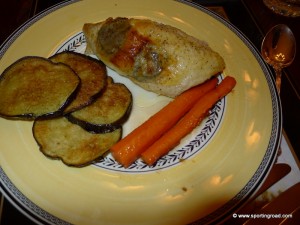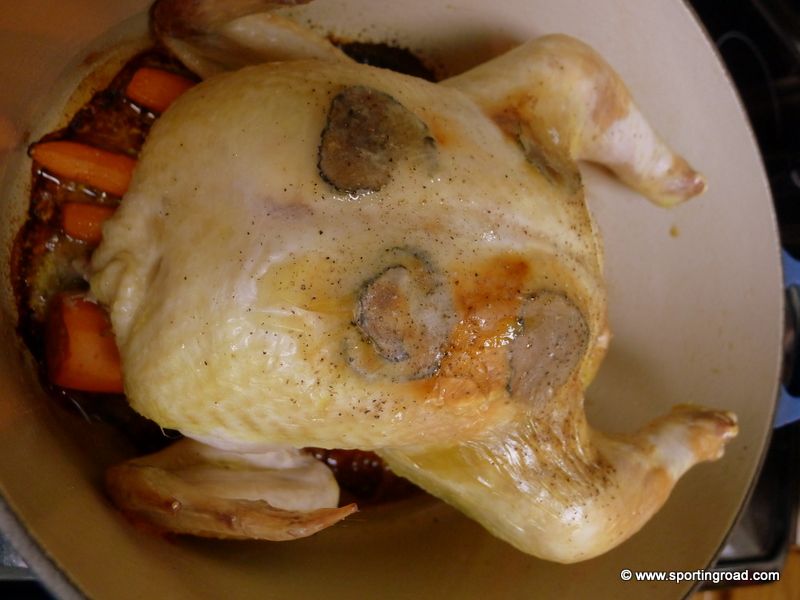Truffled Chicken
Serves 4
This chicken is made in the half-mourning tradition, which is French for the white foods darkened by the black of a truffle. This dish is a simplified version of the classic. Michellin three-star chefs may offer fancier versions of this dish, but you won’t notice a lot of difference, as your guests rave over this pretty presentation of a whole chicken, covered with truffles, baked in a Le Creusot pot.
- 1 three and one-half pound chicken
- 3/4 oz. fresh black truffle, sliced thinly into rounds
- French sea salt and freshly ground pepper
- 2 T. butter, softened
- A few peeled carrots, left whole
- 1 clove garlic, peeled and halved
- 1 T. Madeira
- 1 T. cognac or armagnac
1. Working from the neck opening, use your fingers to pry the skin away from the breast, without tearing it. Slip the truffle slices and butter slices under the skin, covering the bird in a layer inside its own skin. Can leave to marinate overnight in the refrigerator.
2. Preheat oven to 400 degrees. Rub chicken with salt and pepper. Make a rack in the bottom of your Le Cresuet by putting a layer of whole, peeled carrots. Pour madeira and cognac around chicken in the casserole. Cover and bake for one hour. Serve with spetzel or buttered egg noodles.
While the bird cooks, prepare a Side Dish of Sautéed Mushrooms
2 onions sliced lengthwise in half and then 1/4″ wide threads
Take ane equal amount of sliced mushrooms (the good ones) to the onions and clean. In a separate pan, saute the onions in 1/4 c. butter and a little olive oil until browned. Deglaze pan with wine and add the mushrooms, which take less time to cook. Season with salt, pepper, and Cavender’s Greek Seasoning.
A Note about Chickens: Not all Chickens are Alike!
In France and most of Europe, poussin are very popular and have been regularly available since the domesticated wild red jungle fowl. Poussin is the first stage of a chicken’s life (think veal). Next is the poulet. Then, mature females or hens are poules, and the mature males are coqs. Typically, a European goes to market with a specific type of chicken in mind depending upon the recipe. For instance, cooking an old rooster in wine for a long time, coq au vin. Poule au pot, hen in the pot, requires a mature female to mature in the broth and vegetables. Here the coq’s pronounced flavor would be a bit overwhelming. In America, a capon is a reasonable substitute. A capon is gelded male fed milk until 6 months. The flesh is very white and, in France, the capon is traditionally served at Christmas. For everyday roasting or other dry cooking, get a poulet, or pullet, for a bird that will be juicy and tender. A poussin is the most tender, as they are only a month old and purely grain fed.
In the United States, fryers are birds of either sex up to 3 ½ pounds, then come roasters up to 5 pounds, and capons which range from 6-10 pounds. Poussin can be ordered in the US from D’Artagnans.
Better yet, raise your own and you have fresh eggs and the various stages of chickens. Our daughter’s favorite part of our playing polo is collecting eggs from the barn.
________
TIPS EXCERPTED FROM GARDEN & GUN
The Simple Joy of a Perfect Whole Roast Chicken
Start with a high-quality bird.
“Finding the best chicken you can is paramount,” says Little, who recommends home cooks shop from a local farmer or co-op. “This needs to be the chicken-iest chicken you can find, and we’re doing everything we can to help amplify that flavor.” If you don’t know where to start, ask the staff at your favorite restaurant to recommend a local supplier. “They’re going to tell you the best farm to go to, and if they know you’re in an area that’s difficult, they may let you buy one from the restaurant,” Little says. “The better relationships you can have with the people who are growing or cooking your food, the better your meals at home are going to be.”
Don’t wait until the last minute.
You may not need fancy equipment or a ton of experience to get a great roast bird, but you do need to plan ahead. On any given night, chefs at Josephine have around a dozen birds drying for the next night’s dinner service—and Little does the same thing for his own Sunday suppers. “I like to get a chicken at least a day in advance, season it, and let it sit uncovered in the refrigerator so that it has an opportunity to be as dry as possible,” Little says. Seasoning in advance allows the chicken to absorb the flavor all the way through, and eliminating excess moisture on the skin helps it crisp up in the oven. “By Saturday night, I’ll have the chicken seasoned and in the refrigerator trussed and ready to go.”
For the crispiest skin, avoid anything that adds moisture.
“Crispy skin kind of leads you into everything else,” Little says. “The fat content of the chicken is actually helping to flavor the meat as it’s roasting.” Drying out the chicken in the fridge is a great start, but Little keeps the skin top of mind when choosing his sides, too. “A lot of people will recommend putting some vegetables or herbs in the bottom of the pan to lift the chicken up a bit and cook as the chicken is roasting. I don’t do any of that,” he says. “They release steam as they cook, and any bit of added moisture in the oven is working against me.”
Buy a good meat thermometer. Then, relax.
Plenty of chefs roast chicken low and slow, then blast the bird with heat for the last ten or fifteen minutes to crisp up the skin. “Quite honestly, for me, that’s too much work on a Sunday afternoon,” Little says with a chuckle. “I want to be able to heat my oven to 425, set a timer, and then open the wine. For about a four-pound bird, you’re looking at around an hour to get it nicely cooked.” He recommends using a meat thermometer that can go in the oven with the chicken and sound an alarm when the bird has reached the right temperature. (This ThermoWorks model will do the trick.) “Insert it in between the leg and thigh joint of the chicken. I like to take that temp to about 176 degrees, and then let it carry over.” The temperature will continue to rise by a few degrees while the bird rests out of the oven.
Lean into leftovers.
When you’re spending more on a high-quality chicken, stretch it into two or three meals. “You could pick that meat and turn it into chicken salad sandwiches throughout the week. You’ve got the base for a pretty good chicken pot pie, even if you just buy the crust at the grocery store,” he says. “Or take the chicken, with whatever vegetables you had, and put it all together with a little bit of pasta and a touch of dairy. You’ve just made what’s probably a twenty-seven-dollar plate of pasta at a restaurant with your leftovers.”
Waste nothing—not even the bones.
“Save the fats. Any fats,” Little says. “Bacon grease, obviously, is one everybody likes to save. Chicken fat is the same way. Save all of the bones, too. Simply put them in a pot, cover them with cold water, and simmer for a couple hours, then strain everything out, and you’ve got chicken stock.” He recommends straining and freezing leftover chicken fat or homemade stock in ice cube trays. Once the cubes are mostly solid, store them in a sealed container. “Knowing you can reach into the freezer, pull out a little cube of stock or fat to help flavor what you’re cooking—I mean, that’s just one of the best hacks ever.”

